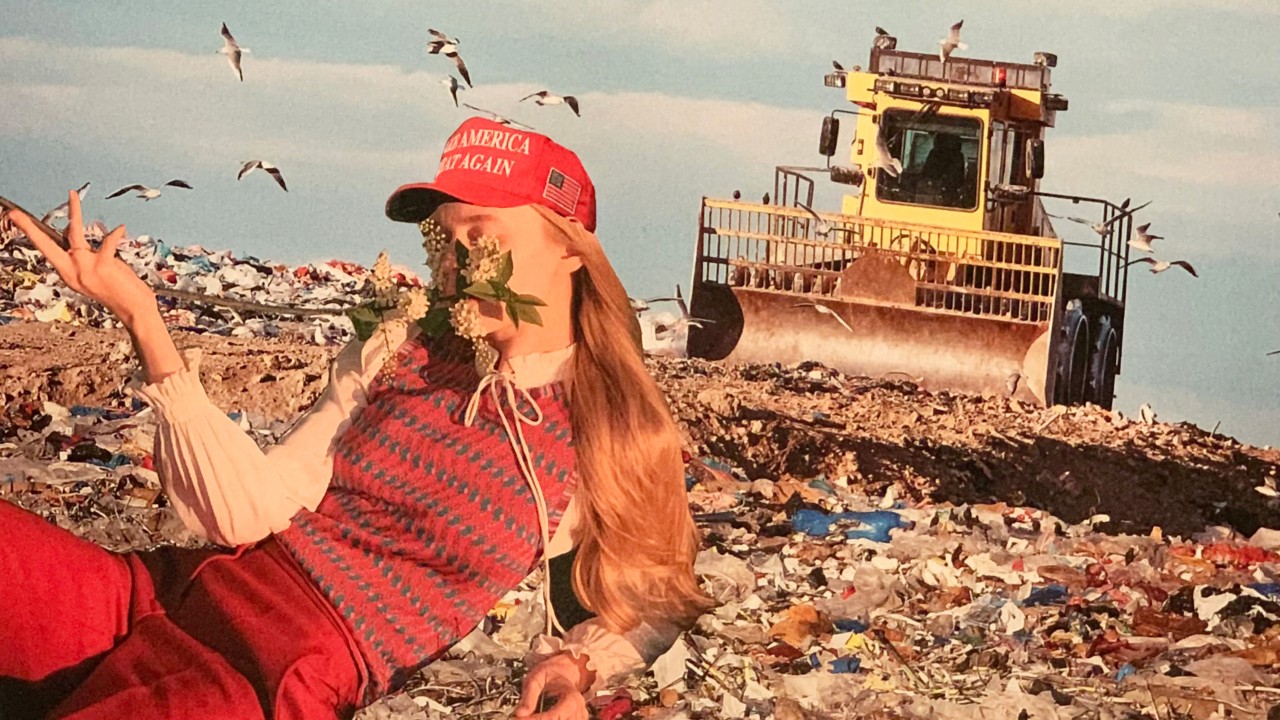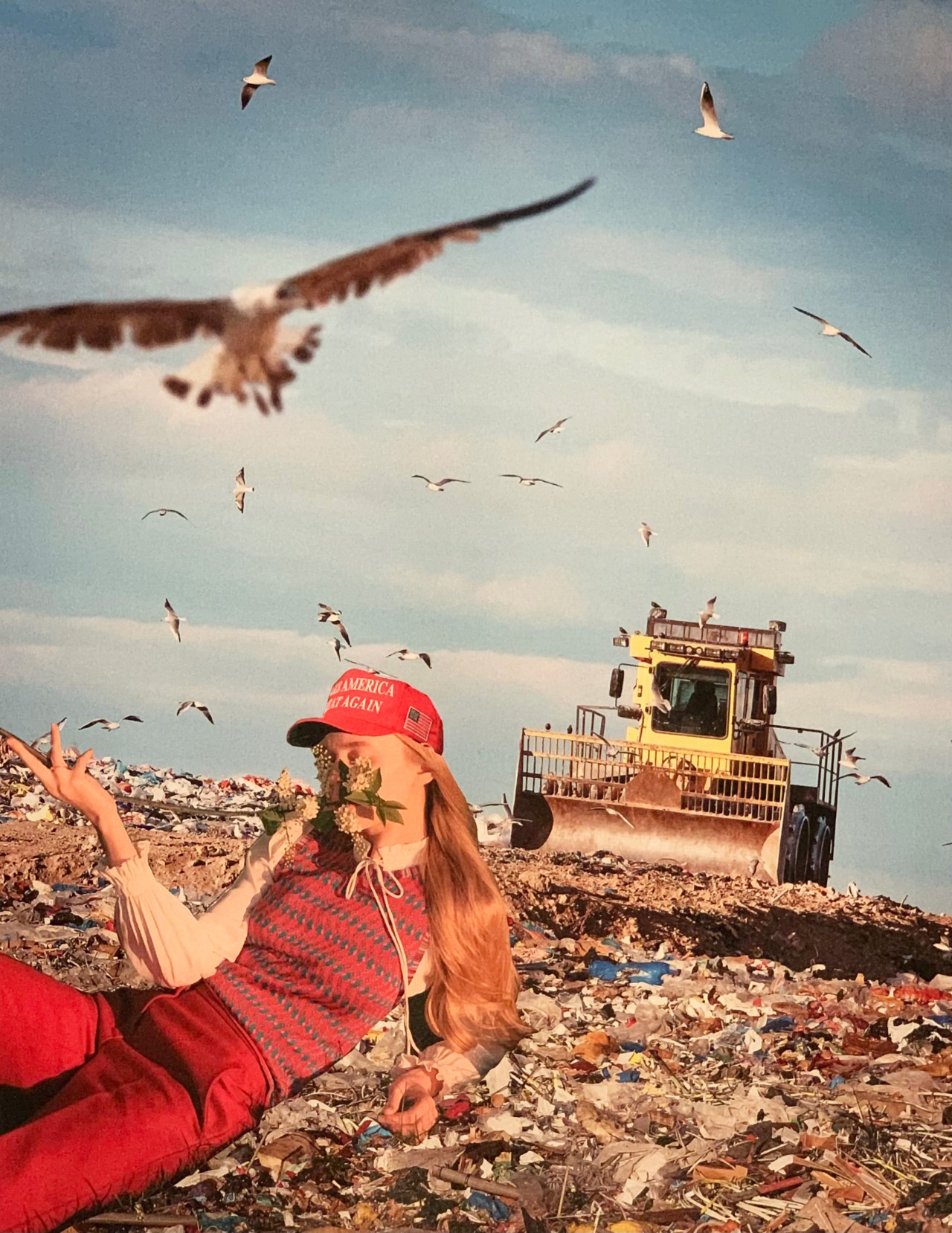

Collage by Yannick Lowery
WORDS BY SARA RADIN
Toxic leggings, shedding bras, body-altering dyes. Lately, it feels like everything we wear is under scrutiny.
And with good reason. In recent years, research has repeatedly shown that the clothes we wear may be making us sick. Harmful substances used during production—BPA, PFAS (or “forever chemicals”), toxic dyes, and certain dyes—have been detected in a wide range of garments and household textiles. These chemicals can seep through the skin, disrupting hormones, weakening the immune system, impairing fertility, and even raising cancer risk.
Yet most shoppers remain unaware of these invisible dangers, since clothing labels rarely disclose the chemical finishes used. Investigations have found items from ultra-fast fashion giants like Temu, Shein, and AliExpress testing positive for these substances, spurring regulators in the United States and European Union to target PFAS in forthcoming public health legislation.
In response, consumers are increasingly ditching fossil-fuel–derived fabrics and reading clothing labels with the same care once reserved for food or skincare. Enter: clean fashion, garments made from organic cotton, hemp, bamboo, or silk, typically free of synthetic dyes and chemical finishes. Like clean beauty before it, the movement promises products gentler on both body and planet—and it’s growing fast.
The climate stakes are high. PFAS and BPA linger in the environment for years—even millennia—and accumulate over time. They contaminate water and soil, and can travel long distances via air and water, polluting regions far from their source and contributing to a global pollution crisis.
But unlike many environmental causes, clean fashion has found support across the political spectrum, a rarity in an era when climate action usually divides along ideological lines. What continues to be a key concern among fair fashion advocates, who frame “clean” products as a step toward a more just system, has also been taken up by conservative influencers. They champion “clean” fabrics through the same anti-establishment lens that fuels raw milk, beef tallow skincare, and other back-to–the-land trends.
Clean fashion, in other words, has become an unexpected common ground for progressives and conservatives alike. How exactly did we get here?
For many, the appeal of “clean” fashion is personal.
“There’s a level of overwhelm people are experiencing when it comes to pollution and toxins in everyday life,” said Summer Dean, founder of Climate Diva. “Part of the reason this ‘clean’ movement has skyrocketed across the political spectrum is because no one can escape toxic pollution, no matter how well-off or privileged they are.”
The notion itself is hardly new. Long before “clean fashion” was coined, Indigenous communities and many non-Western cultures practiced clothing systems grounded in repair, reuse, and respect for natural materials. In the West, today’s movement traces back to the countercultural politics of the 1960s and 1970s when anti-capitalist and naturalist ideals fueled small but influential experiments in rejecting mass production. Homemade, thrifted, or mended clothes became symbols of moral commitment and political dissent. By the 1990s, “sustainable fashion” had entered the mainstream, offering a more palatable, market-friendly version of earlier radical critiques.
As the term spread, however, so did the marketing. Brands launched “eco,” “upcycled,” and even “clean” collections, often without meaningful change to their business models. Critics argue that these efforts, often lacking regulatory oversight, veer into greenwashing. “It’s a marketing term brands can use however they want,” said beauty critic Jessica DeFino.
Even so, “clean” fashion remained a genuine concern for years, driven by grassroots calls for regulation largely confined to left-wing circles and ignored by the wider industry. That is, until today. Dean now sees common ground in the frustrations voiced on both sides of the political spectrum. “Both conservatives and progressives express the same frustration with being taken advantage of by corporate greed,” she said. “The difference is simply what conclusions they reach.”
These divergences are even visible in how clean fashion is worn and what it signals. For climate activists, it’s a sartorial refusal of fast fashion’s waste. For conservative lifestyle brands, it’s pastoral nostalgia, typically in the style of linen dresses, lace, and prairie silhouettes paired with traditional femininity. Brands like Ballerina Farm—a Utah-based lifestyle brand built around trad-wife influencer Hannah Neeleman’s highly stylized portrayals of rural domestic life—and American alt-right women’s media company Evie Magazine are leading examples: Evie recently launched a “milkmaid” dress made from “raw organic cotton” with “100% feminine energy,” according to the magazine’s Instagram. “This idea that all your products should be natural obviously fits into that conservative, idyllic vision of the past that we need to return to,” DeFino said.
“When people overstate the science around toxic chemicals in fashion, beauty, or any industry, it provides ample fodder for backlash and undermines the real issues associated with toxic chemicals.”
The result is an ideological blur, where “raw” cotton dresses signal both eco-consciousness and tradwife nostalgia, and where natural fibers double as climate solutions and markers of cultural identity.
But convergence also brings complications. “When people overstate the science around toxic chemicals in fashion, beauty, or any industry, it provides ample fodder for backlash and undermines the real issues associated with toxic chemicals,” said Lindsay Dahl, activist and author of Cleaning House. Fashion is especially vulnerable, she explained, because while consumer safety dominates headlines, the worst harms fall on workers and communities near production sites. “All too often, the conversation about what is ‘safe’ is focused on how we use the products as consumers, when the larger safety questions are hidden down the supply chain.”
For DeFino, the challenge lies in polarizing narratives. “We tend to associate people on the right with ‘everything is toxic, nothing is safe, only use natural products,’” she said. Meanwhile, the establishment press often suggests that chemical concerns are overblown, framing synthetic ingredients as mostly safe. “‘Everything is safe, there’s no such thing as a bad chemical.’ These are both pretty extreme positions,” she said. “The truth is somewhere in the middle.”
But reaching that middle ground is difficult when “clean” itself has no clear definition in fashion.
Unlike certified terms such as “organic” or “fair trade,” it carries no legal standard in the U.S. or the EU. There are no binding rules on which chemicals must be excluded, how materials are sourced, or what qualifies as “non-toxic.”
That vacuum has consequences. Words like “natural” and “non-toxic” appear everywhere, but with no shared criteria, anyone can use them to mean anything. “The brands don’t have to change how they operate, and consumers think they’re making sustainable choices but aren’t given the evidence of how,” said Teju Adisa-Farrar, executive director of the Black Fiber & Textile Network. “Profit often drives the language more than truth.”
In fact, the language itself has been so normalized that it’s “tricky” to separate genuine safety concerns from opportunistic branding, warned sustainable fashion creator Jazmine Brown. Meanwhile, figures like Robert F. Kennedy Jr. and “MAHA” influencers have adopted the rhetoric to promote broader distrust of science. “What started as a valid critique of corporate chemical overreach and regulatory failure is now reinforcing new kinds of harm,” Brown added.
It’s partly why Dean is skeptical about the conservative embrace of clean fashion. “While [Trump voters] support the ‘clean’ and ‘nontoxic’ movement, they continue to vote for officials who are polluting and killing our environment in every other way,” she said. “Until these communities form a more holistic view of sustainability and wellness, I don’t see much hope in their interest.”
The current administration has already weakened air pollution rules, defunded protections for communities hardest hit by toxic chemical pollution, and delayed long-fought bans on asbestos and PFAS in wastewater. At the same time, proposed legislation that could establish clearer chemical safety standards in the U.S. and in the EU has faced industry pushback and sluggish implementation over the past few years.
“If we reduce consumer safety to a culture war, we risk stalling meaningful reform. We can’t afford to let misinformation or ideology distract us from the real fight. The stakes are too high.”
But meaningful policy momentum is possible. Dahl points to the 2023 update of American cosmetic safety laws—the first overhaul since 1938—as proof that progress can be made when public pressure, science, and legislation align. Similar pushes are now beginning in the supplement industry. “If we reduce consumer safety to a culture war, we risk stalling meaningful reform,” she said. “We can’t afford to let misinformation or ideology distract us from the real fight. The stakes are too high.”
That responsibility extends to brands. Dahl argues they must go beyond vague promises and disclose how they screen ingredients, what testing they conduct, and who on staff has genuine expertise in chemical safety. Too many companies, she notes, make sweeping claims without anyone qualified to guide the ship.
Any serious definition of “clean” must also account for who bears the greatest risks. As is so often the case, those risks are not shared equally: The greatest exposure falls on people with the least protection and power in the fashion supply chain. “We cannot have a conversation about clean fashion without talking about the women most affected by these toxins—Black and Brown garment workers being paid very little for their labor,” Dean said. “We must keep centering them.”
Bridging ideological divides, however uncomfortable, may be the only way to generate the political will for meaningful regulation. Without that broad-based pressure, the regulatory vacuum will likely persist, leaving individuals to shoulder risks they cannot control. Dean remains cautiously optimistic: “The success of the movement [continues to be] questionable if half the momentum comes from folks who support a political foundation of white supremacy and anti-environmental ethics,” she said. “But I am hopeful this bipartisan momentum will [do something to] spark pushes for national legislative action.”
After all, human and planetary health depend on it.
The New Politics of ‘Clean’ Fashion